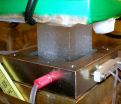(Press-News.org) CORVALLIS, Ore. - A new study shows how huge influxes of fresh water into the North Atlantic Ocean from icebergs calving off North America during the last ice age had an unexpected effect - they increased the production of methane in the tropical wetlands.
Usually increases in methane levels are linked to warming in the Northern Hemisphere, but scientists who are publishing their findings this week in the journal Science have identified rapid increases in methane during particularly cold intervals.
These findings are important, researchers say, because they identify a critical piece of evidence for how the Earth responds to changes in climate.
"Essentially what happened was that the cold water influx altered the rainfall patterns at the middle of the globe," said Rachael Rhodes, a research associate in the College of Earth, Ocean, and Atmospheric Sciences at Oregon State University and lead author on the study, which was funded by the National Science Foundation. "The band of tropical rainfall, which includes the monsoons, shifts to the north and south through the year.
"Our data suggest that when the icebergs entered the North Atlantic causing exceptional cooling, the rainfall belt was condensed into the Southern Hemisphere, causing tropical wetland expansion and abrupt spikes in atmospheric methane," she added.
During the last ice age, much of North America was covered by a giant ice sheet that many scientists believe underwent several catastrophic collapses, causing huge icebergs to enter the North Atlantic - phenomena known as Heinrich events. And though they have known about them for some time, it hasn't been clear just when they took place and how long they lasted.
Rhodes and her colleagues examined evidence from the highly detailed West Antarctic Ice Sheet Divide ice core. They used a new analytical method perfected in collaboration with Joe McConnell at the Desert Research Institute in Reno, Nevada, to make extremely detailed measurements of the air trapped in the ice.
"Using this new method, we were able to develop a nearly 60,000-year, ultra-high-resolution record of methane much more efficiently and inexpensively than in past ice core studies, while simultaneously measuring a broad range of other chemical parameters on the same small sample of ice," McConnell noted.
Utilizing the high resolution of the measurements, the team was able to detect methane fingerprints from the Southern Hemisphere that don't match temperature records from Greenland ice cores.
"The cooling caused by the iceberg influx was regional but the impact on climate was much broader," said Edward Brook, an internationally recognized paleoclimatologist from Oregon State University and co-author on the study. "The iceberg surges push the rain belts, or the tropical climate system, to the south and the impact on climate can be rather significant."
Concentrating monsoon seasons into a smaller geographic area "intensifies the rainfall and lengthens the wet season," Rhodes said.
"It is a great example of how inter-connected things are when it comes to climate," she pointed out. "This shows the link between polar areas and the tropics, and these changes can happen very rapidly. Climate models suggest only a decade passed between the iceberg intrusion and a resulting impact in the tropics."
The study found that the climate effects from the Heinrich events lasted between 740 and 1,520 years.
INFORMATION:
TAMPA, Fla. - Advanced non-small cell lung cancer (NSCLC) patients have few effective treatment options and low 5-year survival rates. The checkpoint inhibitors MEDI4736 and tremelimumab have both demonstrated acceptable safety and potential efficacy when used as single-agents in several different types of cancer. Scott J. Antonia, M.D., Ph.D., chair of the Thoracic Oncology Department at Moffitt Cancer Center will be presenting data from a phase 1b dose-escalation and expansion study of MEDI4736 combined with tremelimumab at the 2015 American Society of Clinical Oncology ...
TAMPA, Fla. - Prostate cancer is the second most common type of cancer in men and is predicted to result in an estimated 220,00 cases in the United States in 2015. In recent years, an emphasis has been placed on chemoprevention - the use of agents to prevent the development or progression of prostate cancer. A team of researchers led by Nagi B. Kumar, Ph.D., R.D., F.A.D.A. at Moffitt Cancer Center recently published results of a randomized trial that assessed the safety and effectiveness of the active components in green tea to prevent prostate cancer development in men ...
TAMPA, Fla. - Chronic myelomonocytic leukemia (CMML) is a rare type of myelodysplastic, myeloproliferative neoplasm characterized by increased numbers of peripheral monocytes and less than 20 percent blasts. CMML has few treatment options and patients only survive on average for 12 to 24 months. Preclinical studies suggest that JAK2 inhibitors may be an effective treatment option for CMML. Eric Padron, M.D., assistant member of the Malignant Hematology Program at Moffitt Cancer Center will report on the first phase 1 study of the JAK2 inhibitor ruxolitinib in CMML patients ...
TAMPA, Fla. - The monoclonal antibody nivolumab has shown promise as a therapeutic agent, particularly by improving the survival rates of melanoma patients. Jeffrey S. Weber, M.D., Ph.D., director of the Donald A. Adam Comprehensive Melanoma Research Center at Moffitt Cancer Center will be presenting data from a retrospective analysis of the safety of nivolumab in 4 ongoing phase I-III studies in melanoma patients at the 2015 American Society of Clinical Oncology Annual Meeting in Chicago.
Nivolumab targets a protein called the programmed death-1 (PD-1) receptor. The ...
Many living things can respond to electric fields, either moving or using them to detect prey or enemies. Weak electric fields may be important growth and development, and in wound healing: it's known that one of the signals that guides cells into a wound to repair it is a disturbance in the normal electric field between tissues. This ability to move in response to an electric field is called galvanotaxis or electrotaxis.
UC Davis dermatology professor Min Zhao, Peter Devroetes at Johns Hopkins University and colleagues hope to unravel how these responses work, studying ...
Unstable funding is threatening the viability of academic biomedical research in this country, according to a new paper published this week in the journal Science Translational Medicine. The paper was written jointly by the deans of 19 prominent medical schools around the country. Among this group is University of Maryland School of Medicine Dean E. Albert Reece.
"We must reinvigorate the federal-academic partnership for research across all sciences," the authors write. If the current trends in funding continue, both established investigators and early-career scientists ...
CHICAGO (May 28, 2015): Traumatic injury is the leading cause of death among people under age 45, but if trauma physicians could deliver plasma to these injury victims within minutes of their arrival in the emergency room, more of them would stand a better chance of survival.
When they arrive at the hospital, trauma victims can often wait 30 minutes or longer to receive plasma because the traditional way of giving them plasma involves two time-consuming steps: testing for blood type and then thawing frozen plasma. "There's a golden hour after trauma where you need to ...
Using a complex modeling program that helps analyze the physical dynamics of large, structurally complex protein molecules, a research team has made progress towards finding a weak spot in the architecture of a group of enzymes that are essential to antibiotic resistance in a number of bacteria.
In an article published in PLOS ONE, University of North Carolina at Charlotte senior biology major Jenna R. Brown and her faculty mentor, UNC Charlotte professor of bioinformatics and genomics Dennis R. Livesay, present an analysis of the four currently known protein structures ...
Immune cells play an important role in the upkeep and repair of our bodies, helping us to defend against infection and disease. Until now, how these cells detect a wounded or damaged site has largely remained a mystery. New research, led by University of Bristol academics in collaboration with a team from the University of Sheffield, has identified the triggers which lead these cells to react and respond in cell repair.
It is hoped the findings, published in Current Biology, could help scientists design therapies to manipulate the cell repair process and direct immune ...
Flies might be smarter than you think. According to research reported in the Cell Press journal Current Biology on May 28, fruit flies know what time of day it is. What's more, the insects can learn to connect different scents with the sweet reward of sugar, depending on the hour: menthol in the morning and mushrooms in the afternoon.
Researchers say that the findings show the surprising mental abilities of animals, no matter how small.
"If even the fly, with its miniature brain, has the sense of time, most animals may have it," says Martin Heisenberg of Rudolf Virchow ...


